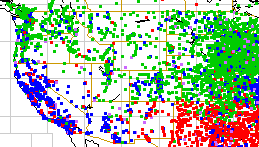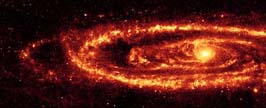Monday, October 31, 2005
Saturday, October 29, 2005
Mars: As Close As It Gets
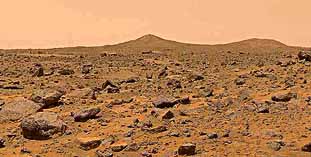
"Mars is close to Earth. Better go out and look, because it won't be this close again until 2018."
Yeah, yeah... didn't we hear this last year? But it still just looks like a point of light. Okay a big, yellowish, point of light.
If you really want to see Mars up close and personal you absolutely won't get any better than these amazing panoramas.
* This one is the best (monochrome but amazing).
* This one is the best color panorama.
* This one is from the 1997 Pathfinder mission.
(NOTE: They're QuickTime Panoramas)
Friday, October 28, 2005
Thursday, October 27, 2005
Earthquake Feeds

Top Men like to keep their finger on the pulse of worldwide geologic activity. It would be nice to have a brief blog entry fed to my reader everytime there was an earthquake over 2.5 anywhere in the world. Oh and what about a real-time earthquake data file that links to Google Earth, too.
Yeah, that would be nice.
Wednesday, October 26, 2005
A Disturbance in the Force Ring

Top Men at NASA released an amazing image of Saturn's F ring today that clearly shows just how disturbed it is. Evidently Saturn's moon Prometheus has a rather eccentric orbit that brings it close enough to the ring (every 14.7 hours) to gravitationally attract bits of the ring. Creates a cool curtain effect.
In December 2009 Prometheus gets close enough to the F ring that it may actually plow through it. That'll be fun.
Tuesday, October 25, 2005
Alka-Seltzer in Space
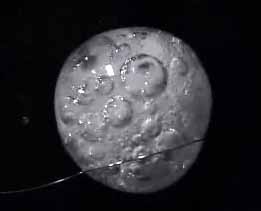
Those poor astronauts on the International Space Station. Month after month of eating freeze-dried rib-eyes and drinking Tang. Boredom and indigestion. But wait, they have a huge supply of Alka-Seltzer, and a micro-gravity environment - why not break the monotony with some "scientific experiments."
They call it "Saturday Morning Science" to make sure you don't confuse it with the big-honkin'-real-expensive-experiments. Here's a fun video of three of them.
Top Men like weightless.
Monday, October 24, 2005
Landing on Venus

The ESA (European Space Agency) has delayed the launch of their Venus Express launch for a few days. While you wait, Top Men thought it would be fun to look at some amazing images of Venus. The Russian Venera spacecraft (9, 10, 13, 14) landed on the cloud shrouded surface of Venus and survived the intense heat long enough (up to a couple hours) to snap a few photos. The Russian exploration of Venus (from 1961 to 1985) was the most extensive of any planet...
...and their ships look flippin' amazing!

Saturday, October 22, 2005
Walking Vegetable?
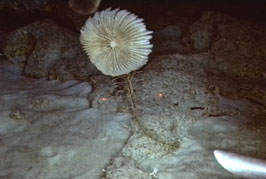
What exactly is the line between animal and vegetable? (Important to know if you're playing Twenty Questions.)
'Cause you see, there's this underwater plant that looks like a dandelion, but sometimes it just lets it stem loose and uses its petals to walk to a new spot. Animal or vegetable?
Vegimal?
Animable?
Friday, October 21, 2005
Thursday, October 20, 2005
Magnetic Liquid Weirdness

Magnetic Fluid or ferrofluid is amazing stuff. It's just runny black oil-like liquid until you put a magnet close to it. With a magnet nearby it forms itself into a solid-like substance. When the magnet is removed it collapses back into liquid form. (A movie's worth a thousand words.)
But wait... that's not all. Top Men are not sure who thought of this (probably the same guy who thought of coffee*) but when you put a drop of this ferrofluid between two glass plates and subject it to powerful rotating magnetic fields, really bizzare patterns appear. Here are some QuickTime movies. The second one starts off slow - but stick with it 'till the stuff at the end. Very weird.
UPDATE: Tom B. sends a link to a beautiful photo of ferrofluid at National Geographic. (Thanks Tom)
---
(*Thought process of the guy who invented coffee: "I have an idea. Let's pick these red cherry things, then dry them in the sun for a week or two, then throw away the fruit and keep the seed, then bake the seed for ten minutes, then grind up the burnt seed, then pour hot water through it, and then drink the brown liquid.")
Wednesday, October 19, 2005
Hurricane Season

Another amazing video from NASA that features this year's entire crop of hurricanes in the Atlantic. This movie covers from June to October (from Arlene to Wilma.)
(Thanks Brice and Chip)
Seasonal Adjustments
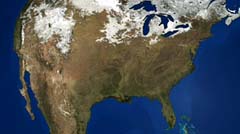
Back in April Top Men at Wohba called your attention to NASA's Blue Marble site - particularly the HUGE images of earth. Well NASA's is raising the bar with Blue Marble: Next Generation. The original Blue Marble was a 1 square kilometer per pixel image made from a composite over several months. The Next Generation actually spans an entire year - one image for each month, each with four times the resolution! That means that each image is rougly 85,000 by 40,000 pixels! And there are twelve of them! (Only available by request - first come, first serve. Top Men will let you know when we get ours.)
They've also put together some amazing movies that show the changes in earth over the months. This movie (8 MB) circles the globe revealing subtle (and not so subtle) surface feature variations throughout the year. And this movie (3 MB) is a closer view of seasonal effects in the eastern United States.
Here are all the Blue Marble: Next Generation movies - including much higher resolution versions for you bit-mongers out there.
Tuesday, October 18, 2005
Dione Flyby Goodies
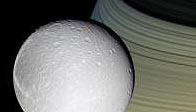
Speaking of Saturn... check out this amazing movie (almost 10 meg) as Cassini approached Dione last Tuesday. The movie covers approximately three hours and is an assembly of approach shots with a dramatic look back at the end.
There are more details (and a smaller version) here.
For a closer view of Dione try this shot (75 feet per pixel.)
Monday, October 17, 2005
Free Saturn Poster

Don't forget to head over to NASA and pick up your free PDF poster of Saturn. It's a spectacular view of the ringed planet, and it's yours for absolutely nothing...
...well, except for the $3.26 billion cost of the Cassini mission.
Sunday, October 16, 2005
Where is Opportunity
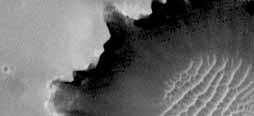
It's been a while since Top Men provided an Opportunity update. The Mars Rover Opportunity has finally reached Erebus crater - moving slowly and deliberately since being trapped in the drift. Erebus is the last major stop before heading on to Victoria crater - by far the largest, youngest, and most well defined crater that we'll get a chance at.
Here is a hi-res view of how things have progressed. So close and yet so far.
Friday, October 14, 2005
Genome Browser

We live in amazing times. Sure we haven't been to the moon in over thirty years, but at least you can browse the entire human genome on the internet. All 3,272,187,692 base pairs.
Top Men at Wohba aren't sure what to do with all this genetic information, but it's nice to know it's there, should we feel the need to... oh... wait... we almost forgot... 20% of human genes have been patented in the United States, primarily by private firms and universities.
Doh (ba).
Let's Get Small

On October 6, 2005, Nikon announced the winners of the 2005 Small World Photomicrography Competition.
From photos of the very large (Andromeda) to photos of the very small. Top Men cover it all.
Thursday, October 13, 2005
Snow-ba!

No two snowflakes are alike? Whatever. Top Men are as skeptical of that as they are of the statement that we only use one tenth of our brains. Both are in the Hard-to-prove category.
But snowflakes look cool. Here are a few great photos. But even more amazing is watching a snowflake grow. Here is a movie, and here is another movie.
Feels like winter.
UPDATE: Here are more snowflake photos. But if you've seen one - you've seen them... oh, wait...
Monday, October 10, 2005
Iron Giant?

Here is an amazing image (using adaptive optics) of the huge sunspot that crossed old Sol at the end of September. Kind of makes you wonder what the heck our Sun is made of.
Which reminds Top Men at Wohba that there is a growing movement that is taking issue with the traditional giant-ball-of-gas model of the sun first posited by Galileo. The leading advocates claim that much of the unexplained solar phenomenon begins to make perfect sense with a solid sun model. Some big-thinkers are even advancing the idea that the sun is substantially iron - with a swirling liquid-like plasma ocean of neon covering the surface. Some other big-thinkers think those first big-thinkers are smokin' something.
This web site presents the case. Here is another for reference.
Top Men are always amazed at how much we know, and how much we don't.
Friday, October 07, 2005
Hand-held Death Ray (batteries not included)

Holy guacamole! Top Men love toys like this - balloon poppin', tape burnin', match lightin', eye blindin' lasers! Sure you won't get one of these babies for $29, but if you're interested, Top Men recommend the GHL-35 - a 35 milliwatt (minimum peak output), handheld, space-age, Ray-Gun Blaster of Death (requires 2 "C" batteries) for only $389.
And remember kids...
"WARNING! These portable laser modules are many times more powerful than regular laser pointers. These products are designed for industrial and scientific use, and are therefore too powerful for use as a pointer for presentations. Momentary eye exposure to the direct beam can cause permanent eye damage."
Sweet!
Tell 'em Wohba sent you.
Weather Gisting

Gisting large amounts of data into visual forms is an interesting challenge. For example: can you present the weather in over one hundred cities around the world without using any text except the name of the city? Could you easily spot the coldest city... the windiest city... the clearest... the most humid?
Not sure if this is the best solution, but Top Men still find it interesting.
Tuesday, October 04, 2005
Solar Eclipse - Don't Look Up

Sometimes it's better to look down during a solar eclipse - cool video in Madrid shot by Nils van der Burg.
Monday, October 03, 2005
Your Topographic Data of Earth
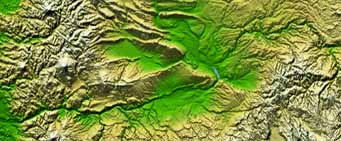
Bear with us, Top Men are trying to help you get what you've already paid for.
In February 2000 Space Shuttle Endeavour spent 11 days in orbit collecting radar topography using a freaky 200 foot mast that extended out of the cargo bay. The objective of this mission was to map 80% of the Earth's land surface by gathering elevation data points every 100 feet. Each elevation measurement was accurate to within 50 feet.
That's a lot of data; 12.3 terabytes* to be exact. It took a year and a half just to process the data. The total mission cost $142 million USD. The most accurate and complete topographic map of the Earth's surface that has ever been assembled.
And it's all yours. You just have to decide how you want it delivered. Top Men at Wohba can help.
Might we suggest starting with the North American Shaded Relief with Height as Color. It's not a small image (9600 x 7240 - over 50 megabytes for the jpeg), but it's pretty amazing.
If you'd like to zoom in on a particular section of the Earth then you might prefer the USGS Seamless Data Distribution. This is like Google Maps on steroids - which means it big, it's mean, and the results are not always what you'd expect - but when it works it's freakin' amazing! There are lots of options in the frame on the right side of the image. To use the Shuttle Radar Topography Mission (SRTM) data, click on the arrow next to Elevation on the right frame, and check only the box next to SRTM Finished 1 arc sec Shaded Relief.
Explore.
--
* That's 12,300 gigabytes. An iPod with that much storage could hold over 3 million songs. At 3 minutes per song it would play continuously without repeating for over 17 years.
Saturday, October 01, 2005
King of the Hill
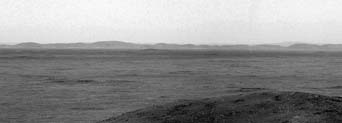
A final hill climbing milestone for the Spirit rover on Mars - the top of Husband Hill. This is highest location in the area so Top Men expect a brief pause here to snap a full series of panoramic photos.
The teeming masses are already assembling some of the first shots into amazing panoramas. Check out the huge dust devil in the middle of this one from Dilo (the imaging leader of the teeming masses.)
It's all downhill from here.
Giant Smoke Rings
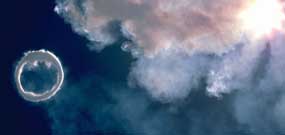
Mt. Etna (Italy), Europe's most active volcano, is known for periodically belching forth lots (up to 100 per day) of gigantic (up to 600 feet in diameter) long-lasting (up to 15 minutes) smoke rings that billow skyward (up to 18,000 feet). Top Men at Wohba have sorted through the droves of images and movies at Stromboli and provide links to the best.
Check out the amazing Stromboli Site for yourself.
(Thanks Ryan)





